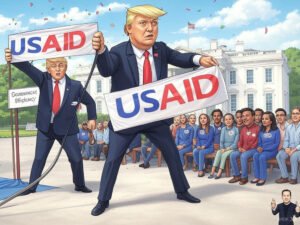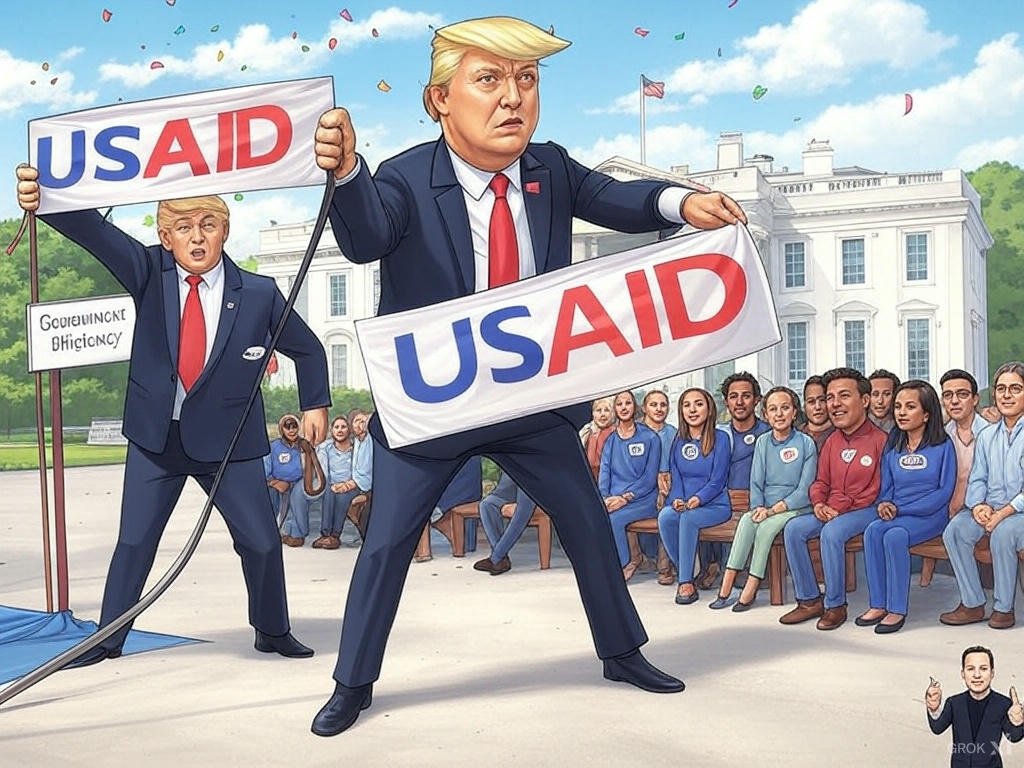In a bold move on February 23, 2025, the Trump administration announced significant changes at the U.S. Agency for International Development (USAID), eliminating 1,600 jobs and placing most of the agency’s remaining workforce on administrative leave. This decision marks a major shakeup for the agency, which has been a key player in U.S. foreign aid for over six decades. Here’s a simple breakdown of what’s happening, why it matters, and what it means for the future.
What’s Happening at USAID?
Starting at midnight Eastern Standard Time on February 23, 2025, nearly all of USAID’s direct-hire employees—except for a small group handling critical missions, leadership roles, or specific programs—will be placed on paid administrative leave. This affects thousands of workers both in the U.S. and overseas. At the same time, the agency is launching a “reduction in force,” which will permanently cut 1,600 positions based in the United States.
This action follows a federal judge’s ruling earlier in the week, allowing the administration to move forward with its plan despite legal challenges from employee unions. The judge determined that the move wouldn’t cause irreparable harm, paving the way for these sweeping changes.
Why Is This Happening?
The Trump administration, backed by Elon Musk’s Department of Government Efficiency (DOGE), aims to slash federal spending and restructure what it calls wasteful or misaligned programs. President Donald Trump and his allies argue that USAID’s foreign aid and development work is inefficient and sometimes promotes a liberal agenda, rather than serving U.S. interests. This move is part of a broader campaign to shrink the federal government and cut costs.
The administration has also faced criticism and scrutiny over USAID’s spending, including claims about funding foreign elections. For example, Trump has publicly questioned why USAID allegedly allocated millions to boost voter turnout in countries like India, calling it unnecessary and questioning the use of U.S. taxpayer money abroad.
Who Is Affected?
- 1,600 Job Cuts: These layoffs target U.S.-based USAID employees, reducing the agency’s domestic workforce significantly.
- Thousands on Leave: Globally, most of USAID’s 4,700 full-time employees are now on paid administrative leave, though a small number of “mission-critical” staff—such as leaders and those in essential programs—will continue working. It’s not yet clear how many employees fall into this exempt category.
- Overseas Staff: Employees stationed abroad will receive voluntary, agency-funded travel to return home and retain access to communication tools, like two-way radios and a phone app with a panic button, for safety.
Additionally, hundreds of USAID contractors have already received termination notices in recent weeks, further shrinking the agency’s workforce from its pre-Trump inauguration total of over 10,000 employees.
What Does This Mean for USAID’s Future?
USAID, founded in 1961 under President John F. Kennedy, has long been a cornerstone of U.S. “soft power,” providing aid for global health, disaster relief, economic development, and democratic governance in over 100 countries. This drastic downsizing could weaken its ability to deliver these programs, raising concerns among critics about the impact on U.S. influence abroad and vulnerable populations worldwide.
However, the administration sees this as a necessary step to refocus federal resources on domestic priorities and eliminate what it considers wasteful spending. The agency will continue operating with a skeleton crew focused on critical functions, but the long-term vision for USAID remains unclear.
Reactions and Controversy
The decision has sparked mixed reactions. Supporters, including some posts on social media platforms, applaud Trump for “keeping promises” to cut government waste and reduce bureaucracy. Others criticize the move as a “bloodbath” that undermines U.S. humanitarian efforts and global leadership.
Legal battles are ongoing, with employee unions suing to block the layoffs and leave policies. A separate court ruling has temporarily restored some foreign aid funding, complicating the administration’s plans. Meanwhile, international partners and aid recipients are watching closely, as USAID’s programs have historically supported projects like health care, education, and environmental sustainability in regions like India, Africa, and Latin America.
Impact on Global Aid and U.S. Policy
The cuts could disrupt U.S. foreign assistance, particularly in countries where USAID funds critical projects. For instance, recent reports highlight USAID’s $750 million investment in seven projects in India during fiscal year 2024, focusing on health, education, and environmental sustainability—not voter turnout, as Trump claimed. These allegations have stirred controversy, with Indian officials clarifying that USAID’s funding was for development, not elections.
Globally, the reduction in USAID’s capacity might force other nations or organizations to fill the gap, potentially shifting the balance of international aid. It could also strain U.S. relationships with allies who rely on USAID for disaster relief, poverty alleviation, and democratic support.
What’s Next?
Over the coming week, USAID plans to provide details on how employees can retrieve personal items and return government-issued devices. The agency will also communicate future updates through official channels. However, the broader implications for U.S. foreign policy, global aid, and USAID’s role remain uncertain as legal battles and political debates continue.
This move underscores Trump’s commitment to shrinking the federal government, but it also raises questions about the cost of such cuts on America’s global standing and humanitarian responsibilities.






